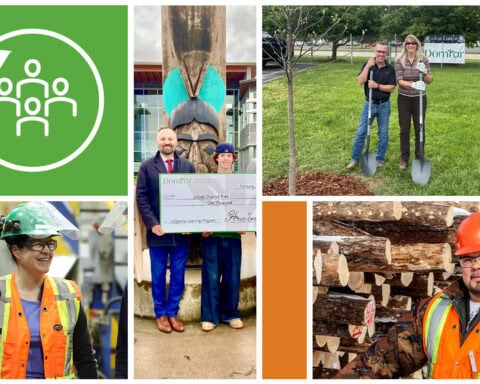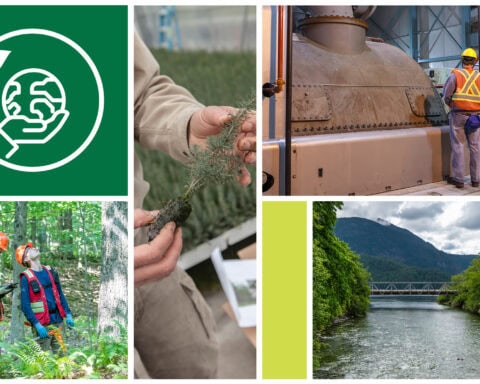This article is “sponsored content” as defined by Corporate Knights’ content disclosure policy.
The urgency to address climate change is ever growing. Businesses are under increasing pressure from investors, legislators, customers, and employees to accelerate their strategic vision and map out a plan of tangible actions. The good news is the technology and know-how exist today to help businesses on their journey to a zero-carbon future. Partnering with organizations that have experience with their own sustainability journey can reduce risk and uncertainty for those that are hesitant to adopt digital solutions. Early adopters of technology have learned that the path towards a zero-emission future requires you to set goals, announce your targets, deploy custom efficiency programs and adjust where necessary – it’s a non-linear and collaborative process that takes time, resources and people to get right. And while digital adoption remains one of the biggest barriers to action, Schneider Electric’s VP of Services, Frederick Morency, says there are four megatrends in commercial sectors that are gathering momentum and enabling businesses to begin their own journeys. The trends driving this action are energy flexibility, digitization, the electricity transition and most importantly, engagement and the human dimension. Together these trends are setting the stage for businesses to achieve their zero-emission goals.
Energy flexibility
“The need for action toward a low-carbon future is undeniable and we must act now,” says Morency. Energy flexibility is fundamental for businesses to deal with the growing demand of energy. To lead in the climate crisis means factoring climate risk into business strategy and identifying opportunities to drive change.
For example, with Canadian buildings still accounting for almost 30 per cent of all emissions, building designs must target zero carbon now if Canada is to reach its goals. “We see transactive energy models becoming a reality where buildings with onsite energy generation would be able to sell their energy back to the grid or with other buildings around them,” says Morency. “Microgrids in a building contribute to creating energy flexibility by enabling us to prioritize in a dynamic way energy efficiency and cost savings, resiliency and reduce CO2 emissions.”
Digitization
Connectivity is increasing the speed, capacity, and reliability of data transmission. “Embracing connected technology and reaping the benefits of digital transformation are critical to reliable and energy efficient solutions for our buildings, factories, transport, and even our homes,” says Morency.
With massive amounts of data flowing from IoT devices, businesses and decision-makers are in information overload. For businesses to action this data, they need the tools and technology to analyze it. Investing in agnostic software solutions can create greater efficiency and resilience, reduce unplanned downtime, and preserve investment value for the long-term. For example, some of the most advanced software available on the market right now issues reminders for maintenance updates and can generate QR codes for electrical panels that facilitate communication between the customer and the building owner.
Integrating process and digital energy technologies and software can help businesses enhance safety, reliability and sustainability. Connectivity is what enables data collection and analysis, so by measuring, monitoring and optimizing energy use, businesses can use connected technologies to make the most out of their resources, reduce waste and make smarter decisions.
The electricity transition
The accelerated transition towards renewable energy is placing a renewed focus on the way electricity is produced, stored, and used by businesses. Morency added, “the increased use of electricity for heating and transportation, and the multi-directional flow of information and energy are contributing to the reinvention of the electricity sector.” There is a growing emphasis on a more decentralized system providing a clean, reliable, and resilient supply of electricity through a grid that supports multi-directional flows of energy and information between producers, consumers, and “prosumers” – buildings and households that both take from and contribute electricity to grid.
One place these ideas are being translated to reality is the partnership with the Centre for Grid Innovation at the Northern Alberta Institute of Technology (NAIT) in Edmonton where Schneider Electric’s EcoStruxure Microgrid Operation (EMO) is being installed to extend the Centre’s capability to support Alberta businesses in the testing and implementation of distributed energy resources (DER).
“Distributed energy resources are becoming an increasingly favourable option for consumers and distribution entities, especially as the demand for energy grows in popularity,” says Morency. “NAIT’s Centre for Grid Innovation is an exciting step forward for Alberta’s changing energy landscape, providing small and medium enterprises with the ability to develop, test and optimize their solutions against real-world factors. We’re excited to partner with NAIT to support Alberta’s growing distributed electricity sector.”
Engagement and the human dimension
None of this is possible however without engaged citizens empowered to make bold decisions and hold their businesses accountable. “The pathway to carbon neutrality and net zero emissions is achievable,” according to Morency. He’s quick to point out, however, it is the human dimension that determines success or failure. “We have the greatest success when senior management takes a leadership position and works collaboratively to develop a comprehensive strategy to meet both business objectives and climate commitments, driving both profit and purpose. This is a journey, and we are all on it together.”
The collaboration between Schneider Electric and Maple Leaf Foods exemplifies the results that can be achieved when CEO leadership and Board commitment are aligned with sustainability goals and science-based targets. Science-based targets show companies how much and how quickly they need to reduce their greenhouse gas (GHG) emissions to prevent the worst effects of climate change. As the leading North American producer of meat and plant proteins and the first major food company in the world to be carbon neutral Maple Lead Foods acknowledges the impact of the global food system on the environment and the urgent need for transformative change to reduce global greenhouse gas emissions to zero. “Maple Leaf Foods deep commitment to sustainability leadership is carving the path for others to set bold environmental goals and most importantly – act on them,” said Morency.
With an aggressive target of reducing emissions 50 per cent by 2025, Maple Leaf Foods is well on its way to its ultimate goal of reducing its carbon footprint to zero. Since 2015, the company has reduced over 86 million kilowatt hours of electricity – equal to 12,912 passenger vehicles driven for one year — and over 4.3 million m3 of natural gas, which equals annual energy usage for 1,000 homes. Through its water conservation efforts, Maple Leaf Foods has reduced water usage by over 1.2 billion liters. They are also investing in wind energy, landfill gas methane recovery, composting and biomass programs to reduce methane emissions, and forest protection and re-forestry to conserve species and biodiversity.
The path towards a zero-emission future isn’t just being socially responsible for the short-term, it’s about survival in the long-term,” said Morency. “Canadians rightfully expect business to be at the forefront of these solutions, and we’re here to do exactly that.”





